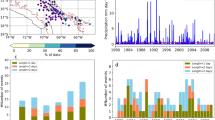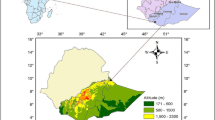Abstract
Differences between anomalously wet and dry rainy seasons over the period 1961–2001 in Equatorial East Africa (Kenya, northern Tanzania) are studied at local scale using a 53 rain-gauge network and analysing six intra-seasonal characteristics (ISCs): the onset and end dates, the wet spells number and length, daily mean rainfall amount and the dry spells length. As compared to anomalously dry Long Rains, anomalously wet ones record earlier onsets, more wet spells with higher daily mean rainfall amounts (above 14 mm/day). For the Short Rains, the end date is also widely modulated across the rain gauge network, and daily mean rainfall amounts above (below) 10 mm/day are more (less) frequent during anomalously wet (dry) seasons. The differences in the number, length and daily mean rainfall amount of wet spells between anomalously wet and anomalously dry rainy seasons is also analysed in an ensemble of 24 sea surface temperature-forced runs of the ECHAM4.5 Atmospheric General Circulation Model. For the Long Rains, results are inconsistent between runs which suggests a lack of reproducibility of the ISCs in the model. For the Short Rains, the ISCs distributions between anomalously wet and anomalously dry years are significantly different in most of the runs/locations. In particular, daily mean rainfall amounts above 8 mm/day are more (less) frequent in the model during anomalously wet (dry) years.










Similar content being viewed by others
Abbreviations
- ISCs:
-
Intra-seasonal components
- NWS:
-
Number of wet spells
- LWS:
-
Mean length of wet spells
- IWS:
-
Daily mean rainfall amount of wet spells
- LDS:
-
Mean length of dry spells
- OD:
-
Onset date
- ED:
-
End date
- KS test:
-
Kolmogorov–Smirnov test
References
Allan R, Chambers D, Drosdowsky W et al (2001) Is there an Indian Ocean dipole, and is it independent of the El Niño-Southern Oscillation ? Clivar Exch 6:18–22
Behera S, Luo J, Masson S et al (2005) Paramount impact of the Indian Ocean dipole on the East African short rains: a CGCM study. J Clim 18:4514–4530
Black E, Slingo J, Sperber K (2003) An observational study of the relationship between excessively strong short rains in coastal East Africa and Indian Ocean SST. Mon Weather Rev 131:74–94
Boyard-Micheau J, Camberlin P, Philippon N, Moron V (2013) Regional-scale rainy season onset detection: a new approach based on multivariate analysis. J Clim 26:8916–8928. doi:10.1175/JCLI-D-12-00730.1
Camberlin P, Philippon N (2002) The East African March–May rainy season: associated atmospheric dynamics and predictability over the 1968–97 period. J Clim 15:1002–1019. doi:10.1175/1520-0442(2002)015<1002:TEAMMR>2.0.CO;2
Camberlin P, Wairoto J (1997) Intraseasonal wind anomalies related to wet and dry spells during the “long” and “short” rainy seasons in Kenya. Theor Appl Climatol 58:57–69
Camberlin P, Moron V, Okoola R et al (2009) Components of rainy seasons’ variability in Equatorial East Africa: onset, cessation, rainfall frequency and intensity. Theor Appl Climatol 98:237–249. doi:10.1007/s00704-009-0113-1
Gitau W, Ogallo L, Okoola R (2012) Spatial coherence and potential predictability assessment of intraseasonal statistics of wet and dry spells over. Int J Climatol. doi:10.1002/joc.3620
Hastenrath S, Polzin D, Mutai C (2007) Diagnosing the 2005 drought in Equatorial East Africa. J Clim 20:4628–4637. doi:10.1175/JCLI4238.1
Indeje M, Semazzi FHM, Ogallo LJ (2000) ENSO signals in East African rainfall seasons. Int J Climatol 20:19–46. doi:10.1002/(SICI)1097-0088(200001)20:1<19:AID-JOC449>3.0.CO;2-0
Ines AVM, Hansen JW (2006) Bias correction of daily GCM rainfall for crop simulation studies. Agric For Meteorol 138:44–53
Kabanda TA, Jury MR (2000) Synoptic evolution of composite wet spells over northern Tanzania. Clim Res 15:239–248
Laing AG, Carbone RE, Levizzani V (2011) Cycles and propagation of deep convection over equatorial Africa. Mon Weather Rev 139:2832–2853. doi:10.1175/2011MWR3500.1
Latif M, Dommenget D, Dima M, Grötzner A (1999) The role of Indian Ocean sea surface temperature in forcing East African rainfall anomalies during December–January 1997/98. J Clim 12:3497–3504. doi:10.1175/1520-0442(1999)012<3497:TROIOS>2.0.CO;2
Lyon B (2014) Seasonal drought in the greater horn of Africa and its recent increase during the March–May long rains. J Clim 27:7953–7975. doi:10.1175/JCLI-D-13-00459.1
Lyon B, DeWitt DG (2012) A recent and abrupt decline in the East African long rains. Geophys Res Lett. doi:10.1029/2011GL050337
Mapande AT, Reason CJC (2005) Interannual rainfall variability over western tanzania. Int J Climatol 25:1355–1368. doi:10.1002/joc.1193
Marteau R, Moron V, Philippon N (2009) Spatial coherence of monsoon onset over Western and Central Sahel (1950–2000). J Clim. doi:10.1175/2008JCLI2383.1
Moron V, Robertson AW, Ward MN, Camberlin P (2007) Spatial coherence of tropical rainfall at the regional scale. J Clim 20:5244–5263. doi:10.1175/2007JCLI1623.1
Moron V, Camberlin P, Robertson AW (2013) Extracting subseasonal scenarios: an alternative method to analyze seasonal predictability of regional-scale tropical rainfall. J Clim 26:2580–2600. doi:10.1175/JCLI-D-12-00357.1
Mutai C, Ward M (2000) East African rainfall and the tropical circulation/convection on intraseasonal to interannual timescales. J Clim 13:3915–3939
Mutai CC, Ward MN, Colman AW (1998) Towards the prediction of the East Africa short rains based on sea-surface temperature–atmosphere coupling. Int J Climatol 18:975–997. doi:10.1002/(SICI)1097-0088(199807)18:9<975:AID-JOC259>3.0.CO;2-U
Nguyen H, Duvel J-P (2008) Synoptic wave perturbations and convective systems over equatorial Africa. J Clim 21:6372–6388. doi:10.1175/2008JCLI2409.1
Oettli P, Camberlin P (2005) Influence of topography on monthly rainfall distribution over East Africa. Clim Res 28:199–212
Ogallo L (1989) The spatial and temporal patterns of the East African seasonal rainfall derived from principal component analysis. Int J Climatol 9:145–167
Ogallo LJ, Chillambo WA (1982) The characteristics of wet spells in Tanzania. East Afr Agric For J 47:87–95
Okoola RE, Camberlin P, Ininda JM (2008) Wet periods along the East African Coast and the extreme wet spell of October 1997. J Kenya Meteorol Soc 2:67–83
Philippon N, Camberlin P, Fauchereau N (2002) Empirical predictability study of October–December East African rainfall. Q J R Meteorol Soc 128:2239–2256. doi:10.1256/qj.01.190
Philippon N, Doblas-Reyes FJ, Ruti PM (2010) Skill, reproducibility and potential predictability of the West African monsoon in coupled GCMs. Clim Dyn 35:53–74. doi:10.1007/s00382-010-0856-5
Philippon N, Rouault M, Richard Y, Favre A (2012) The influence of ENSO on winter rainfall in South Africa. Int J Climatol 32:2333–2347. doi:10.1002/joc.3403
Pohl B, Camberlin P (2006a) Influence of the Madden–Julian Oscillation on East African rainfall. I: intraseasonal variability and regional dependency. Q J R Meteorol Soc 132:2521–2539. doi:10.1256/qj.05.104
Pohl B, Camberlin P (2006b) Influence of the Madden–Julian Oscillation on East African rainfall: II. March–May season extremes and interannual variability. Q J R Meteorol Soc 132:2541–2558. doi:10.1256/qj.05.223
Ricciardulli L, Sardeshmukh P (2002) Local time- and space scales of organized tropical deep convection. J Clim 15:2775–2790
Robertson AW, Qian J-H, Tippett MK et al (2012) Downscaling of seasonal rainfall over the Philippines: dynamical versus statistical approaches. Mon Weather Rev 140:1204–1218. doi:10.1175/MWR-D-11-00177.1
Roeckner E, Arpe K, Bengtsson L et al (1996) The atmospheric general circulation model ECHAM4: model description and simulation of present-day climate. Max Planck Institut für Meteorologie, Report no 218, p 90
Ropelewski CF, Bell MA (2008) Shifts in the statistics of daily rainfall in South America conditional on ENSO phase. J Clim 21:849–865. doi:10.1175/2007JCLI1617.1
Rowell DP (1998) Assessing potential seasonal predictability with an ensemble of multidecadal GCM simulations. J Clim 11:109–120
Schmidli J, Frei C, Vidale PL (2006) Downscaling from GCM precipitation: a benchmark for dynamical and statistical dowscaling methods. Int J Climatol 26:679–689
Sivakumar M (1988) Predicting rainy seasons potential from the onset of rains in Southern Sahelian and Sudanian climatic zones of West Africa. Agric For Meteorol 42:295–305
Smirnov N (1984) Table for estimating the goodness of fit of empirical distributions. Ann Math Stat 19:279–281
Stern RD, Dennett MD, Garbutt DJ (1981) The start of the rains in West Africa. J Climatol 1:59–68. doi:10.1002/joc.3370010107
Tilya F, Mhita MS (2007) Frequency of wet and dry spells in Tanzania. In: Sivakumar MVK, Ndiang’ui N (eds) Clim L Degrad Environmen. Springer, Berlin, pp 197–204
Tipping ME, Bishop CM (1999) Probabilistic principal component analysis. J R Stat Soc B 61:611–622
Werner A, Maharaj AM, Holbrook NJ (2011) A new method for extracting the ENSO-independent Indian Ocean dipole: application to Australian region tropical cyclone counts. Clim Dyn 38:2503–2511. doi:10.1007/s00382-011-1133-y
Widmann ML, Bretherton CS, Salathe EPJ (2003) Statistical precipitation downscaling over the Northwestern United States using numerically simulated precipitation as a predictor. J Clim 16:799–816
Yang W, Seager R, Cane M, Lyon B (2014) The East African long rains in observations and models. J Clim. doi:10.1175/JCLI-D-13-00447.1
Acknowledgments
This study has been funded by Grant #ANR-08-VMCS-001 under the project PICREVAT. The assistance of the Kenya and Tanzania national meteorological services for provision of part of the rainfall data is gratefully acknowledged. We also acknowledge the International Research Institute for Climate and Society (IRI) for providing freely the ECHAM4.5 24 historical runs. The three reviewers are thanked for their encouragement and constructive comments which have helped at improving the manuscript.
Author information
Authors and Affiliations
Corresponding author
Rights and permissions
About this article
Cite this article
Philippon, N., Camberlin, P., Moron, V. et al. Anomalously wet and dry rainy seasons in Equatorial East Africa and associated differences in intra-seasonal characteristics. Clim Dyn 45, 2101–2121 (2015). https://doi.org/10.1007/s00382-014-2460-6
Received:
Accepted:
Published:
Issue Date:
DOI: https://doi.org/10.1007/s00382-014-2460-6




